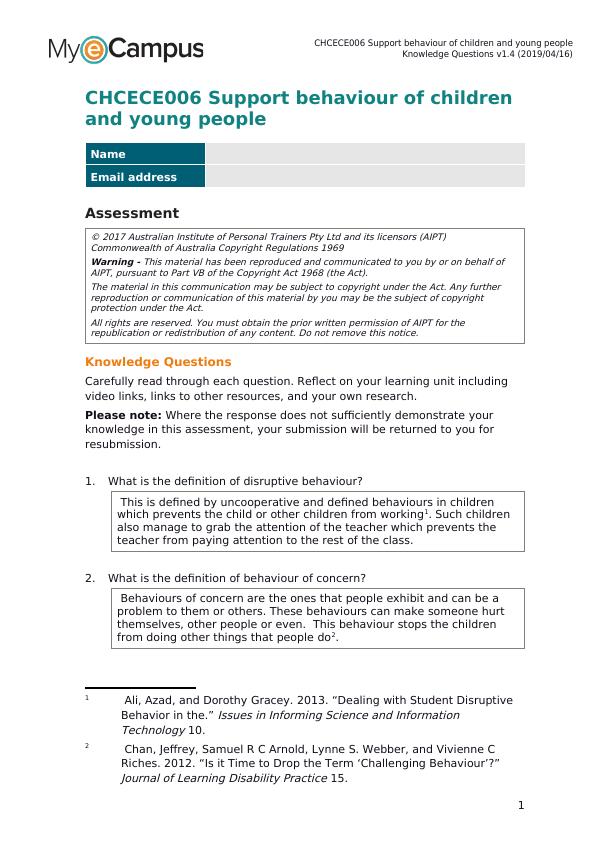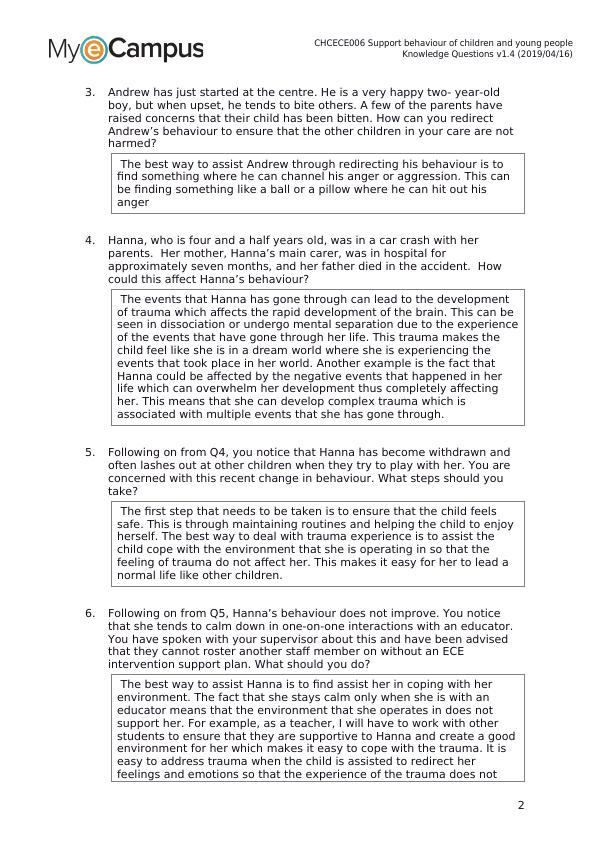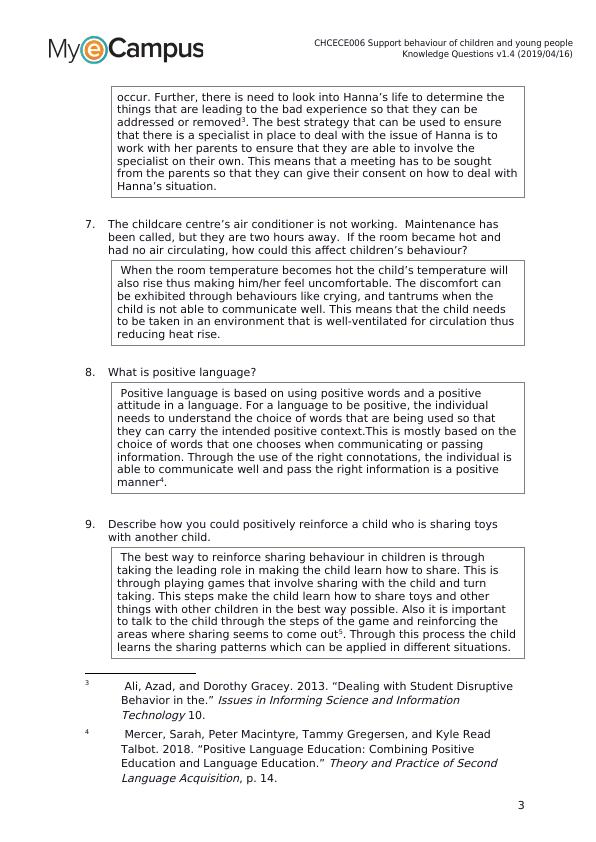Support behaviour of children and young people.
Added on 2022-08-08
8 Pages3096 Words67 Views
CHCECE006 Support behaviour of children and young people
Knowledge Questions v1.4 (2019/04/16)
CHCECE006 Support behaviour of children
and young people
Name
Email address
Assessment© 2017 Australian Institute of Personal Trainers Pty Ltd and its licensors (AIPT)
Commonwealth of Australia Copyright Regulations 1969
Warning - This material has been reproduced and communicated to you by or on behalf of
AIPT, pursuant to Part VB of the Copyright Act 1968 (the Act).
The material in this communication may be subject to copyright under the Act. Any further
reproduction or communication of this material by you may be the subject of copyright
protection under the Act.
All rights are reserved. You must obtain the prior written permission of AIPT for the
republication or redistribution of any content. Do not remove this notice.
Knowledge Questions
Carefully read through each question. Reflect on your learning unit including
video links, links to other resources, and your own research.
Please note: Where the response does not sufficiently demonstrate your
knowledge in this assessment, your submission will be returned to you for
resubmission.
1. What is the definition of disruptive behaviour?
This is defined by uncooperative and defined behaviours in children
which prevents the child or other children from working1. Such children
also manage to grab the attention of the teacher which prevents the
teacher from paying attention to the rest of the class.
2. What is the definition of behaviour of concern?
Behaviours of concern are the ones that people exhibit and can be a
problem to them or others. These behaviours can make someone hurt
themselves, other people or even. This behaviour stops the children
from doing other things that people do2.
1 Ali, Azad, and Dorothy Gracey. 2013. “Dealing with Student Disruptive
Behavior in the.”
Issues in Informing Science and Information
Technology 10.
2 Chan, Jeffrey, Samuel R C Arnold, Lynne S. Webber, and Vivienne C
Riches. 2012. “Is it Time to Drop the Term ‘Challenging Behaviour’?”
Journal of Learning Disability Practice 15.
1
Knowledge Questions v1.4 (2019/04/16)
CHCECE006 Support behaviour of children
and young people
Name
Email address
Assessment© 2017 Australian Institute of Personal Trainers Pty Ltd and its licensors (AIPT)
Commonwealth of Australia Copyright Regulations 1969
Warning - This material has been reproduced and communicated to you by or on behalf of
AIPT, pursuant to Part VB of the Copyright Act 1968 (the Act).
The material in this communication may be subject to copyright under the Act. Any further
reproduction or communication of this material by you may be the subject of copyright
protection under the Act.
All rights are reserved. You must obtain the prior written permission of AIPT for the
republication or redistribution of any content. Do not remove this notice.
Knowledge Questions
Carefully read through each question. Reflect on your learning unit including
video links, links to other resources, and your own research.
Please note: Where the response does not sufficiently demonstrate your
knowledge in this assessment, your submission will be returned to you for
resubmission.
1. What is the definition of disruptive behaviour?
This is defined by uncooperative and defined behaviours in children
which prevents the child or other children from working1. Such children
also manage to grab the attention of the teacher which prevents the
teacher from paying attention to the rest of the class.
2. What is the definition of behaviour of concern?
Behaviours of concern are the ones that people exhibit and can be a
problem to them or others. These behaviours can make someone hurt
themselves, other people or even. This behaviour stops the children
from doing other things that people do2.
1 Ali, Azad, and Dorothy Gracey. 2013. “Dealing with Student Disruptive
Behavior in the.”
Issues in Informing Science and Information
Technology 10.
2 Chan, Jeffrey, Samuel R C Arnold, Lynne S. Webber, and Vivienne C
Riches. 2012. “Is it Time to Drop the Term ‘Challenging Behaviour’?”
Journal of Learning Disability Practice 15.
1

CHCECE006 Support behaviour of children and young people
Knowledge Questions v1.4 (2019/04/16)
3. Andrew has just started at the centre. He is a very happy two- year-old
boy, but when upset, he tends to bite others. A few of the parents have
raised concerns that their child has been bitten. How can you redirect
Andrew’s behaviour to ensure that the other children in your care are not
harmed?
The best way to assist Andrew through redirecting his behaviour is to
find something where he can channel his anger or aggression. This can
be finding something like a ball or a pillow where he can hit out his
anger
4. Hanna, who is four and a half years old, was in a car crash with her
parents. Her mother, Hanna’s main carer, was in hospital for
approximately seven months, and her father died in the accident. How
could this affect Hanna’s behaviour?
The events that Hanna has gone through can lead to the development
of trauma which affects the rapid development of the brain. This can be
seen in dissociation or undergo mental separation due to the experience
of the events that have gone through her life. This trauma makes the
child feel like she is in a dream world where she is experiencing the
events that took place in her world. Another example is the fact that
Hanna could be affected by the negative events that happened in her
life which can overwhelm her development thus completely affecting
her. This means that she can develop complex trauma which is
associated with multiple events that she has gone through.
5. Following on from Q4, you notice that Hanna has become withdrawn and
often lashes out at other children when they try to play with her. You are
concerned with this recent change in behaviour. What steps should you
take?
The first step that needs to be taken is to ensure that the child feels
safe. This is through maintaining routines and helping the child to enjoy
herself. The best way to deal with trauma experience is to assist the
child cope with the environment that she is operating in so that the
feeling of trauma do not affect her. This makes it easy for her to lead a
normal life like other children.
6. Following on from Q5, Hanna’s behaviour does not improve. You notice
that she tends to calm down in one-on-one interactions with an educator.
You have spoken with your supervisor about this and have been advised
that they cannot roster another staff member on without an ECE
intervention support plan. What should you do?
The best way to assist Hanna is to find assist her in coping with her
environment. The fact that she stays calm only when she is with an
educator means that the environment that she operates in does not
support her. For example, as a teacher, I will have to work with other
students to ensure that they are supportive to Hanna and create a good
environment for her which makes it easy to cope with the trauma. It is
easy to address trauma when the child is assisted to redirect her
feelings and emotions so that the experience of the trauma does not
2
Knowledge Questions v1.4 (2019/04/16)
3. Andrew has just started at the centre. He is a very happy two- year-old
boy, but when upset, he tends to bite others. A few of the parents have
raised concerns that their child has been bitten. How can you redirect
Andrew’s behaviour to ensure that the other children in your care are not
harmed?
The best way to assist Andrew through redirecting his behaviour is to
find something where he can channel his anger or aggression. This can
be finding something like a ball or a pillow where he can hit out his
anger
4. Hanna, who is four and a half years old, was in a car crash with her
parents. Her mother, Hanna’s main carer, was in hospital for
approximately seven months, and her father died in the accident. How
could this affect Hanna’s behaviour?
The events that Hanna has gone through can lead to the development
of trauma which affects the rapid development of the brain. This can be
seen in dissociation or undergo mental separation due to the experience
of the events that have gone through her life. This trauma makes the
child feel like she is in a dream world where she is experiencing the
events that took place in her world. Another example is the fact that
Hanna could be affected by the negative events that happened in her
life which can overwhelm her development thus completely affecting
her. This means that she can develop complex trauma which is
associated with multiple events that she has gone through.
5. Following on from Q4, you notice that Hanna has become withdrawn and
often lashes out at other children when they try to play with her. You are
concerned with this recent change in behaviour. What steps should you
take?
The first step that needs to be taken is to ensure that the child feels
safe. This is through maintaining routines and helping the child to enjoy
herself. The best way to deal with trauma experience is to assist the
child cope with the environment that she is operating in so that the
feeling of trauma do not affect her. This makes it easy for her to lead a
normal life like other children.
6. Following on from Q5, Hanna’s behaviour does not improve. You notice
that she tends to calm down in one-on-one interactions with an educator.
You have spoken with your supervisor about this and have been advised
that they cannot roster another staff member on without an ECE
intervention support plan. What should you do?
The best way to assist Hanna is to find assist her in coping with her
environment. The fact that she stays calm only when she is with an
educator means that the environment that she operates in does not
support her. For example, as a teacher, I will have to work with other
students to ensure that they are supportive to Hanna and create a good
environment for her which makes it easy to cope with the trauma. It is
easy to address trauma when the child is assisted to redirect her
feelings and emotions so that the experience of the trauma does not
2

CHCECE006 Support behaviour of children and young people
Knowledge Questions v1.4 (2019/04/16)
occur. Further, there is need to look into Hanna’s life to determine the
things that are leading to the bad experience so that they can be
addressed or removed3. The best strategy that can be used to ensure
that there is a specialist in place to deal with the issue of Hanna is to
work with her parents to ensure that they are able to involve the
specialist on their own. This means that a meeting has to be sought
from the parents so that they can give their consent on how to deal with
Hanna’s situation.
7. The childcare centre’s air conditioner is not working. Maintenance has
been called, but they are two hours away. If the room became hot and
had no air circulating, how could this affect children’s behaviour?
When the room temperature becomes hot the child’s temperature will
also rise thus making him/her feel uncomfortable. The discomfort can
be exhibited through behaviours like crying, and tantrums when the
child is not able to communicate well. This means that the child needs
to be taken in an environment that is well-ventilated for circulation thus
reducing heat rise.
8. What is positive language?
Positive language is based on using positive words and a positive
attitude in a language. For a language to be positive, the individual
needs to understand the choice of words that are being used so that
they can carry the intended positive context.This is mostly based on the
choice of words that one chooses when communicating or passing
information. Through the use of the right connotations, the individual is
able to communicate well and pass the right information is a positive
manner4.
9. Describe how you could positively reinforce a child who is sharing toys
with another child.
The best way to reinforce sharing behaviour in children is through
taking the leading role in making the child learn how to share. This is
through playing games that involve sharing with the child and turn
taking. This steps make the child learn how to share toys and other
things with other children in the best way possible. Also it is important
to talk to the child through the steps of the game and reinforcing the
areas where sharing seems to come out5. Through this process the child
learns the sharing patterns which can be applied in different situations.
3 Ali, Azad, and Dorothy Gracey. 2013. “Dealing with Student Disruptive
Behavior in the.”
Issues in Informing Science and Information
Technology 10.
4 Mercer, Sarah, Peter Macintyre, Tammy Gregersen, and Kyle Read
Talbot. 2018. “Positive Language Education: Combining Positive
Education and Language Education.”
Theory and Practice of Second
Language Acquisition, p. 14.
3
Knowledge Questions v1.4 (2019/04/16)
occur. Further, there is need to look into Hanna’s life to determine the
things that are leading to the bad experience so that they can be
addressed or removed3. The best strategy that can be used to ensure
that there is a specialist in place to deal with the issue of Hanna is to
work with her parents to ensure that they are able to involve the
specialist on their own. This means that a meeting has to be sought
from the parents so that they can give their consent on how to deal with
Hanna’s situation.
7. The childcare centre’s air conditioner is not working. Maintenance has
been called, but they are two hours away. If the room became hot and
had no air circulating, how could this affect children’s behaviour?
When the room temperature becomes hot the child’s temperature will
also rise thus making him/her feel uncomfortable. The discomfort can
be exhibited through behaviours like crying, and tantrums when the
child is not able to communicate well. This means that the child needs
to be taken in an environment that is well-ventilated for circulation thus
reducing heat rise.
8. What is positive language?
Positive language is based on using positive words and a positive
attitude in a language. For a language to be positive, the individual
needs to understand the choice of words that are being used so that
they can carry the intended positive context.This is mostly based on the
choice of words that one chooses when communicating or passing
information. Through the use of the right connotations, the individual is
able to communicate well and pass the right information is a positive
manner4.
9. Describe how you could positively reinforce a child who is sharing toys
with another child.
The best way to reinforce sharing behaviour in children is through
taking the leading role in making the child learn how to share. This is
through playing games that involve sharing with the child and turn
taking. This steps make the child learn how to share toys and other
things with other children in the best way possible. Also it is important
to talk to the child through the steps of the game and reinforcing the
areas where sharing seems to come out5. Through this process the child
learns the sharing patterns which can be applied in different situations.
3 Ali, Azad, and Dorothy Gracey. 2013. “Dealing with Student Disruptive
Behavior in the.”
Issues in Informing Science and Information
Technology 10.
4 Mercer, Sarah, Peter Macintyre, Tammy Gregersen, and Kyle Read
Talbot. 2018. “Positive Language Education: Combining Positive
Education and Language Education.”
Theory and Practice of Second
Language Acquisition, p. 14.
3

End of preview
Want to access all the pages? Upload your documents or become a member.
Related Documents
CHCPRT001 Identify and Respond to Children and Young People at Risk - Knowledge Questionslg...
|6
|2558
|453
CHCECE001 Develop Cultural Competence Assignment 2022lg...
|16
|5472
|158
Use information about children to inform practicelg...
|8
|2592
|23
CHCECE011 | Provide Experiences to Support Children's Play and Learninglg...
|10
|3311
|12
Play and Development Assessment Workbook for CHC50113 Diploma in Early Childhood Education & Carelg...
|79
|11241
|285
CHC50113 Subject 4 Assessment Workbook - Play and Developmentlg...
|74
|12540
|455
